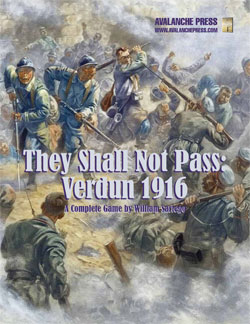| War in
Theory and Practice
The French Army 1914-1916
By William Sariego
April 2020
 No nation or army was prepared for August 1914 and its aftermath.
All had envisioned a short and sharp war of mobility, and
yet “home before the leaves fall” would prove
a naïve sentiment to say the least. No national army,
however, underwent such a radical change in both doctrine
and equipment as that of the French during the 16 months from
the start of the war to the opening guns at Verdun, the subject
of They Shall Not Pass. No nation or army was prepared for August 1914 and its aftermath.
All had envisioned a short and sharp war of mobility, and
yet “home before the leaves fall” would prove
a naïve sentiment to say the least. No national army,
however, underwent such a radical change in both doctrine
and equipment as that of the French during the 16 months from
the start of the war to the opening guns at Verdun, the subject
of They Shall Not Pass.
Le Pantalon Rouge C’Est la France!
France went to war with uniforms little changed since the
Second Empire. Indeed, the famous red pants originated before
that, in 1829 in an odd economic effort to boost the madder
industry against British competition; the red dyes were a
byproduct of the madder plant. The red pants, dark blue greatcoat
and the kepi were as outdated in 1914 as Napoleonic tactics.
Other armies had long given up their colorful uniforms. The
British had begun to phase in khaki after the Boer War, and
the Germans switched from Prussian blue to field grey in 1910.
The French army, to its credit, had experimented as early
as 1902 with a different uniform, but the issue was political
at that point. The red trousers had become a perverse symbol
of nostalgia and past glory. A last effort in 1912 for an
earthen toned uniform (it would have looked similar to that
of the Italian army) came to naught.
After the death of so many brave young men in 1914, even
the most naïve politician came to realize something must
be done. The choice of bleu clair, or horizon blue, remains
something of a mystery, but is probably related to the dyes
available in the wartime conditions.
Anything was an improvement. Alistair Horne, in his magnificent
book, The Path of Glory, remarked upon the positive morale
effects on British troops when French reinforcements appeared
to materialize on the horizon in their blue uniforms.
Oddly enough, colonial troops, both native and metropolitan,
would be issued khaki uniforms. The kepi would be replaced
by a steel helmet similar to that worn by the Italians. Transition
to the new style of dress began in April 1915.
L'Artillerie
In 1909, a forgettable member of the General Staff uttered
words that would echo the pre-war French disdain for artillery.
“You talk to us of heavy artillery. Thank God we have
none!” That was a something of an overstatement, but
not by much, and reflected the army’s attitude well
enough. Heavy artillery was deemed contrary to the mission
of the army, which saw as its strength the lightness of its
guns. To this end the French army entered the war with the
75mm artillery piece as its staple. Luckily for them, it was
one of the finest field guns ever designed. Mobile with a
high rate of fire, it was longer-ranged and more accurate
than any of its peers.
Yet the Great War demonstrated the need for bigger guns, especially
when the war of mobility ended and the trenches were dug. That
France had any heavy guns at all was largely due to General
Joseph Joffre’s efforts before he took command of the
army. As an engineer he recognized the need for heavy guns to
breach fortified zones. After stalemate set in, more guns were
ordered. Joffre’s vision on this point, however, nearly
proved fatal to France when the Germans launched their offensive
at Verdun. To compensate for the shortage of heavy guns until
more could be manufactured, most of the forts depicted on the
map to They Shall Not Pass had their big guns removed
to support his 1915 offensives.
Revanche!
The French strategy against Germany would come full circle.
Following the debacle of the Franco-Prussian War, a resumption
of hostilities at a later date was assumed. French strategy
in preparation for this future war was defensive in nature.
Her great fortifications at Verdun, Belfort and other places
reflected this. Yet as time passed it became clear to military
strategists that to win back the lost provinces of Alsace
and Lorraine the country would have to take the offensive.
The doctrine of the offensive served to boost the morale of
the army, humiliated in 1870-1871. L’attaque a l'outrance would become an idea so fixed in the military and political
mindset that officers who counseled caution found their careers
ruined.
Historians commonly point out that Plan 17 was a failure.
Granted, but the Schlieffen Plan also failed in the end. The
plan of attack was quite flexible, and the French generals
were hardly ignoring the real potential of the Germans sweeping
through Belgium. As the Germans advanced with their “right
hook,” the French hoped to hit and break through the
center, unhinging the German offensive. It did not happen
that way, as we well know. Tactics had not kept up with technology,
and many brave soldiers died in these futile attacks. In the
end, France did win the war and regain her lost territory.
She did this however, thanks to the tenacity of her soldiers
on the defensive, such as during the epic struggle at Verdun.
Put
your own theories to the test in They
Shall Not Pass!
Sign up for our newsletter right here. Your info will never be sold or transferred; we'll just use it to update you on new games and new offers.
|
